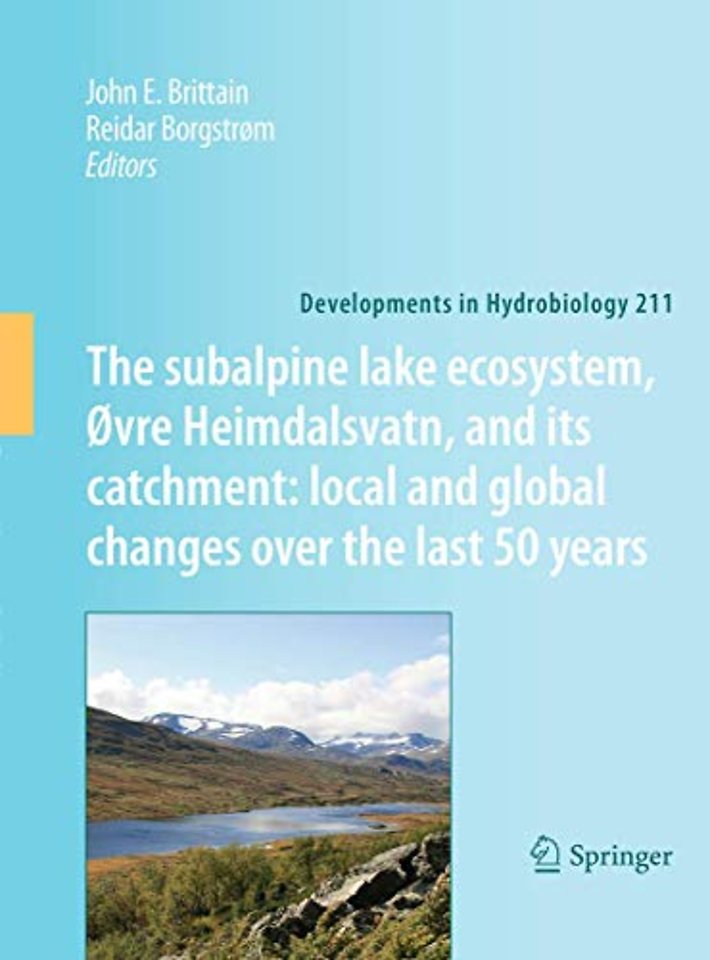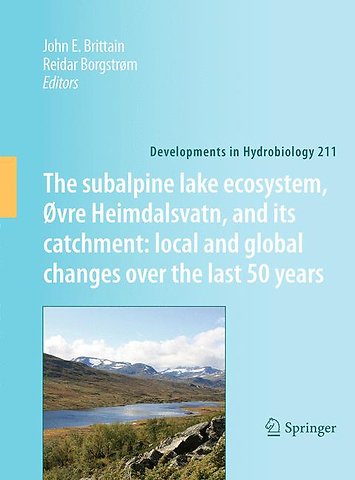The subalpine lake ecosystem, Øvre Heimdalsvatn, and its catchment: local and global changes over the last 50 years
Paperback Engels 2014 9789401781992Samenvatting
environmental variables are estimated and then applied to fossil assemblages under the assumption Plant and animal remains are often found well that the biota is in equilibrium with concurring preserved and in large quantities as fossils in lake environmental conditions. We have used fossil pollen sedimentary deposits. The composition of the fossil assemblages to reconstruct changes in past mean July assemblages, the biological proxies, can be used to air temperatures and changes in mean annual prec- infer environmental conditions at the time of de- itation (Birks & Birks, 2003). Plant macrofossils were sition. This is based on the uniformitarian assumption used to con?rm and to give more robust interpre- that particular species assemblages of the past have tions about past vegetation and climate than the been shaped by speci?c sets of environmental pollen evidence alone (Birks & Birks, 2000) and has conditions, and that these conditions are re?ected been widely used to con?rm the local presence of tree by the same species assemblages today (Rymer, species in studies of past tree-lines (Barnekow, 2000; 1978; Birks & Birks, 1980). Different proxies used to Bjune, 2005; Eide et al. , 2006). Chironomids (n- reconstruct past environmental conditions have in- biting midges) were used to infer past mean July air vidual strengths and weaknesses.
Specificaties
Lezersrecensies
Inhoudsopgave
John E. Brittain and Reidar Borgstrøm
The Norwegian reference lake ecosystem, Øvre Heimdalsvatn
John E. Brittain and Reidar Borgstrøm
Holocene climate and environmental history of Brurskardstjørni, a lake in the catchment of Øvre Heimdalsvatn, south-central Norway
Gaute Velle, Anne E. Bjune, Jorunn Larsen and H. John B. Birks
The development of new algorithms for remote sensing of snow conditions based on data from the catchment of Øvre Heimdalsvatn and the vicinity
Rune Solberg, Hans Koren, Jostein Amlien, Eirik Malnes, Dagrun Vikhamar Schuler and Nils Kristian Orthe
Long-term trends in water temperature and ice cover in the subalpine lake, Øvre Heimdalsvatn, and nearby lakes and rivers
Ånund Sigurd Kvambekk and Kjetil Melvold
Between-year variations in the development of crustacean zooplankton in the Norwegian subalpine lake, Øvre Heimdalsvatn
Petter Larsson, Heidi Hansen and Linda Kristin Bjørnstad Helland
Long-term changes in the littoral benthos of a Norwegian subalpine lake following the introduction of the European minnow (Phoxinus phoxinus)
Frode Næstad and John E. Brittain
The brown trout (Salmo trutta) in the lake, Øvre Heimdalsvatn: long-term changes in population dynamics due to exploitation and the invasive species, European minnow (Phoxinus phoxinus)
Reidar Borgstrøm, Jon Museth and John E. Brittain
Diet overlap between introduced European minnow (Phoxinus phoxinus) and young brown trout (Salmo trutta) in the lake, Øvre Heimdalsvatn: a result of abundant resources or forced niche overlap?
Jon Museth, Reidar Borgstrøm and John E. Brittain
A long-term study of catchment inputs of 137Cs to a subalpine lake in the form of allochthonous terrestrial plant material
John E. Brittain and Helge E. Bjørnstad
Long-term trends and variation in 137Cs activity concentrations in brown trout (Salmo trutta) from Øvre Heimdalsvatn, a Norwegian subalpine lake
John E. Brittain and Jan Egil Gjerseth
The importance ofsize and growth rate in determining mercury concentrations in European minnow (Phoxinus phoxinus) and brown trout (Salmo trutta) in the subalpine lake, Øvre Heimdalsvatn
Marthe T. Solhaug Jenssen, Reidar Borgstrøm, Brit Salbu and Bjørn Olav Rosseland
Rubrieken
- advisering
- algemeen management
- coaching en trainen
- communicatie en media
- economie
- financieel management
- inkoop en logistiek
- internet en social media
- it-management / ict
- juridisch
- leiderschap
- marketing
- mens en maatschappij
- non-profit
- ondernemen
- organisatiekunde
- personal finance
- personeelsmanagement
- persoonlijke effectiviteit
- projectmanagement
- psychologie
- reclame en verkoop
- strategisch management
- verandermanagement
- werk en loopbaan

